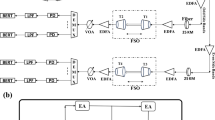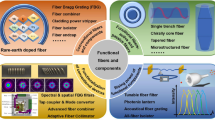Abstract
An analytical theory describing the frequency chirp characteristics of the wavelength converted signal in wavelength conversion based on cross-gain modulation (XGM) in semiconductor optical amplifier (SOA) is derived. By computation, we can see that low input pump power, high probe power, small line-width enhancement factor and low unsaturated single-pass gain of the SOA are favorable for reducing the frequency chirp of the wavelength converted signal. The analytical results have significance in understanding and designing wavelength converters.
Similar content being viewed by others
REFERENCES
Jaafar M.H. Elmirghani and Hussein T. Mouftah, “All-optical wavelength conversion: Technologies and applications in DWDM networks,” IEEE Communications Magazine, vol.38, pp.86-92, 2000.
Shibao Wu et al., “Wavelength Conversion in WDM All-Optical networks and Analytical Models,” International Journal of Infrared and Millimeter Waves, vol. 21, pp.2055-2063, 2000.
R. A. Barry and P. A. Humblet, “Models of blocking probability in all optical networks with and without wavelength changers.” IEEE J. Select. Areas commun., vol, 14, pp. 858-867, 1996.
Terji Durhuus, Benny Mikkelsen et al., “All-optical wavelength conversion by semiconductor optical amplifiers.” IEEE J.Lightwave Technol., vol. 14, pp.942-954, 1996.
Mehdi Asghari and Richard V. Penty, “Wavelength conversion Using semiconductor optical Amplifiers”, J. Lightwave Technol.,vol. 15,pp.1181-1190, 1997.
K. Inoue, “Dependence of chirping influence on probe input power in wavelength conversion based on cross-gain saturation in a semiconductor optical amplifier,” Electron.Lett.,vol.32. pp.584-585,1996.
Govind P. Agrawal, Anders Olsson, “Self-Phase Modulation and Spectral Broadening of Optical Pulses in Semiconductor Laser Amplifiers,” J Quantum Electron, vol.25, pp.2297-2306, 1989.
Kristof Obermann et al., “Performance analysis of wavelength converters based on cross-gain modulation in semiconductor-optical amplifiers,” IEEE J.Lightwave Technol., vol.16, pp.78-85, 1998.
Toshio Watanabe, Norio Sakaida et al., “Transmission Performance of Chirp-Controlled Signal by Using Semiconductor Optical Amplifier,” IEEE J.Lightwave Technol., vol.18, pp.1069-1076, 2000.
Author information
Authors and Affiliations
Rights and permissions
About this article
Cite this article
Wu, S., Sun, X. & Zhang, M. Characteristics of the Wavelength Converted Signal in Wavelength Conversion Based on Cross-Gain Modulation. International Journal of Infrared and Millimeter Waves 23, 309–316 (2002). https://doi.org/10.1023/A:1015082520555
Issue Date:
DOI: https://doi.org/10.1023/A:1015082520555




